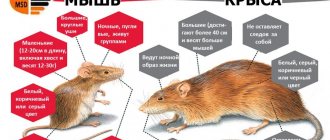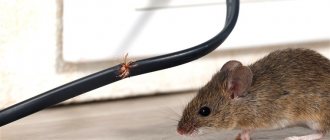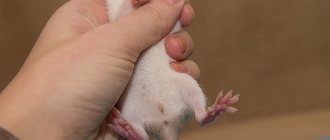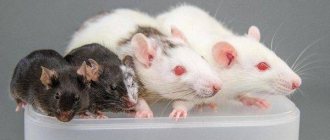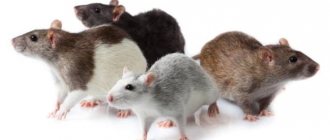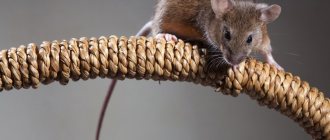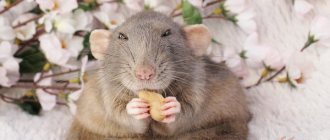Many people living in private homes are interested in the difference between a mouse and a rat. The point is not that both of them carry various infections, but that one should begin to fight rodents by determining their type. Thanks to this, it will be possible to choose an effective way to destroy them. To understand the differences between a mouse and a rat, you should know the structural features of the body of these similar animals.
Many people living in private homes are interested in the difference between a mouse and a rat.
Appearance
Mouse Rat
To the uninformed person, rats and mice appear almost identical due to their elongated body, gray fur and long tail. Both animals actually belong to the same mouse family. But they belong to different species, and differ in appearance in several ways:
- Body dimensions. Rats are much larger. Their body length (without tail) is on average 22-25 cm, although there are also individuals up to 30 cm long. Weight - 400-500 g. Mice are more compact - the distance from the tip of the nose to the tail is only 8-11 cm. And they weigh mice 50-80 g.
- Tail. Mouse tails are relatively short - their length is approximately 55-60% of the length of the body. Rats use their tail as a fifth limb, so they have it thicker and longer. Its length is comparable to the size of the animal's body.
- Head. The muzzle of rats is more elongated and pointed, with relatively small beady eyes and triangular or oval ears. Mice have a more rounded muzzle with larger eyes. Their ears are also much larger and have a rounded shape. Mice can easily wiggle their ears and turn their heads in all directions without using their entire body. Rats have immobile ears; to look to the side, they need to turn their body.
- Paws. Mice have more graceful paws with prehensile claws that help them easily climb vertical surfaces. The paws of rats are more powerful, and there are rough skin growths between the toes.
- Wool. If we talk about wild rats, their fur is quite hard to the touch and has a dirty gray color. The fur of mice is softer, shimmers pleasantly in the sun and has an interesting smoky gray hue. Decorative rats, unlike their wild relatives, also boast beautiful soft fur of a wide variety of colors.
Sometimes among pasyuks there are individuals of gigantic size. The body length of wild rats can reach 40-45 cm, and the weight is about 1 kilogram.
Duration and lifestyle
Mouse
Rats, like mice, are predominantly nocturnal. During the day they rest and gain strength, and after sunset they go hunting in search of food. Despite the fact that both species of rodents live in packs, mice hunt alone.
Rats, on the contrary, prefer to attack prey in large groups. Therefore, they can be dangerous even for animals that are much larger than themselves. Rats are also more aggressive - in a fight with an enemy, they go to the last, fighting for life and death.
The lifespan of mice is slightly shorter than that of rats. On average, mice live 1-1.5 years. However, at home they can live up to 2.5 years. The lifespan of a rat is somewhat longer - 2.5-3 years. Although this indicator can vary greatly depending on the type of rat. For example, albinos rarely live longer than one and a half years.
Reasons for incompatibility
As mentioned above, these rodents do not interbreed. In addition, these animals are natural enemies. It's no secret that a rat destroys caught prey (a mouse), but can also eat it if there is no danger. If an adult rat gets into a place inhabited by mice, then, most likely, the latter will be killed or expelled in a fairly short period of time. Note that the very presence of rats in a place where there is a concentration of mice leads to great concern for them.
This is explained by the fact that, according to some data, mice can detect the smell of rats, which for them is the smell of danger. It is for this reason that pets of different species should not be in the same cage.
Therefore, it is important to know how mice differ from rats; the signs are extremely significant. After all, if you decide to have such pets, then it is better to keep them away from each other, in separate cages located in different rooms
Character and behavior
Little Rat
Mice and rats, especially decorative ones, are peaceful animals that are not prone to unreasonable aggression. The only exception is that during sexual activity and during hunting, rats can be very militant.
When it comes to relationships with people, mice are more timid. Seeing a person or hearing his approaching steps, the mouse will immediately hide so as not to become noticed.
Rats are calmer and more sociable. They are much easier to tame. In addition, decorative rats interact well with other pets. The main thing is to carefully monitor the interaction of pets in order to come to the rodent’s aid if a large animal (cat or dog) suddenly awakens its hunting instinct.
How to determine the type of spoiled food
You can also distinguish a mouse from a mouse by the type of spoiled food.
If rodents are indoors, their species can be determined by the following behavioral characteristics:
- Flakes. When eating grains, rats eat the grains without leaving any traces. Mice leave husks and spoiled grains.
- Small family members prefer to eat in only one place, while large ones cause great harm to the family and food supplies, each time choosing new food sources.
If rodents have settled indoors, it is important to be able to identify their species, since methods of dealing with them are different. To kill mice, you need to collect a trap or insecticide; To get rid of large rodents, you need to call professional pest controllers, as these animals are extremely careful, cunning and witty.
Intelligence
Little Rat
It has now been proven that the cognitive abilities of rats are much higher than those of mice. They adapt faster to changing environmental conditions, are more careful, and are able to independently regulate the size of the flock. For example, if the demographic situation declines, rats begin to actively reproduce. Mice do not have such abilities.
Scientists have found that the intelligence of rats is comparable to that of a cat or dog. Ornamental rodents can even be trained by performing simple commands and tricks. A domestic rat is able to respond to its name and use the litter tray to go to the toilet.
For a long time, it was believed that among all mammals, only humans were given the ability to smile. However, it has recently been discovered that rats also have a sense of humor. And if you wish, sometimes you can notice a slight smile on their sly little face.
Rats are also more social. They are able to take care of their relatives - they lick each other, feed weakened and sick individuals, and warn of approaching danger. Often rats even sleep together, in groups, pressed tightly against each other.
Amazing moments from the life of rodents
Facts about rats Interesting facts about rats are regularly published in the press around the world. An experiment was carried out. Several wild rats from the same family were placed in a glass container. One of them was placed in another box side by side. They threw food at her, but when the animal began to eat, her other relatives were shocked. The animal saw all this suffering through the glass. As a result, 90% of individuals chose their own death and refused to eat.
A lot of interesting:
- From whom rats originated, there are many versions. Some believe that these are space aliens transmitting signals to distant worlds. The fact confirms that animals arose 48 million years earlier than humans. But they could have happened in the process of evolution.
- The joints of rats have the same structure as human ones, with an equal number of bones.
- Gray rats or pasyuki develop speeds of up to 10 km per hour, jump in a calm state up to 80 cm in height, and when aggressive - up to 200 cm in height and length. Pasyuk can swim on water for 3 days. The recorded record is a distance of 30 km. If there is no way to get to land, he will drown.
- Rats squeak in the ultrasonic range, remaining invisible to predators. They communicate with each other, warn about danger, about finding food.
- The rat is the only mammal that can laugh. Scientists recorded the animal's smile while showing a funny video. It has been established that these rodents dream.
- During a mass extinction event, rats are not in danger of becoming extinct. The number is regulated by nature due to the increase in rat pups in one litter. A pair of rats can reproduce about 2 thousand rat pups in a year, creating their own numerous colony with a leader and several dominant females.
- There is a version that rats caused the extinction of dinosaurs. They regularly sucked out the eggs, preventing the young from developing. The number of rats in the world is such that there are 2 rodents per person. In those days the colonies were just as numerous.
- In a year, one individual is capable of devouring 12 kg of various food, the damage from spoilage of supplies and containers is several times greater.
You can endlessly cite interesting facts from the life of rats. For these reasons, these animals are preferred to dogs, cats, and kept as pets. Translated from Chinese, the word “rat” means happiness.
Nutrition
Baby rat
Both types of rodents are omnivores; if necessary, they will find food in any conditions. However, their food preferences are still different. Rats are true predators; their diet necessarily includes animal protein. Therefore, owners of decorative rodents must include the following products in their daily menu:
- lean meat - chicken breasts, rabbit, turkey, lean beef;
- boiled fish;
- seafood - shrimp, crabs, squid;
- fermented milk products - crumbly cottage cheese, yogurt without dyes, curdled milk, Varenets;
- dried mealworm and insects.
Mice are also not averse to eating protein food, but they tolerate its absence much more calmly. The basis of the diet of tiny animals is cereals (wheat, rye, oats, rice, millet), as well as seeds of various plants. They can attack insects and are also not averse to eating their larvae. In conditions of food shortage, they can even feed on leather items, soap, and paraffin.
If we talk about the drinking regime, then in rats it is more plentiful. For normal functioning of a sexually mature individual, 30-35 ml of liquid is required. It is enough for a mouse to drink 10 times less water - about 3 ml.
The difference between a mouse and a rat
Baby rat
Baby rats and mice are born very tiny, completely naked and blind. Therefore, it is simply impossible to distinguish them at first glance. However, for experienced zoologists, the differences between newborn mice and rat pups are obvious:
- mice have a round body shape, while the body of baby rats is oblong;
- the little mice are distinguished by a slightly flattened muzzle, while the little rats' faces are stretched forward;
- mouse ears have an almost round shape and are quite large compared to the size of the head; the ears of baby rats are smaller and slightly pointed or blunt at the tips;
- rat pups have a more developed tail - it is quite thick and long, while mouse tails are short and graceful, and also more mobile;
- during sleep, baby rats prefer to roll over on their backs and spread their paws in different directions, while mice sleep in a ball, like kittens;
- Mouse paws lack the characteristic webbing between the toes of rats.
If you look at the litter as a whole, you can determine whether it belongs to one or another species by the number of babies. Mice give birth to fewer babies - 5-10. In rats, the offspring are more numerous - each pregnancy ends with the birth of 12-15 rat pups. Sometimes the number of rat droppings reaches 22-24 pups.
As they get older, the differences become more obvious. Mice open their eyes earlier - after about 5 days, and are completely covered with hair after 10 days. In rat pups, these physiological processes take approximately 2 times longer. But at two weeks of age, the baby rat’s body parameters are comparable to the size of an adult mouse.
What are the similarities between a mouse and a rat?
Mice
Despite the large number of differences between rats and mice, these representatives of rodents have much in common. For example:
- lead a predominantly nocturnal lifestyle;
- similarity in appearance - achieved thanks to gray fur, large front incisors and a bare tail;
- both types of animals are inextricably linked with humans - wild rats look for food among household waste, and mice prefer to feast on farmland;
- have high vitality, are mobile, flexible - they constantly study the world around them and are always ready to frolic;
- live in numerous colonies, in which a clear hierarchy can be traced;
- cleanliness - rodents carefully wash themselves and lick each other’s fur; they also maintain cleanliness in their homes;
- both types of animals are easily tamed - currently breeders have created many decorative subspecies of mice and rats that are ideally adapted to life at home.
Separately, we can note the very high fertility of both rats and mice. Females of both rodent species are ready to mate within a few hours of giving birth. Therefore, if the reproduction process is not limited by artificial means, females will be constantly involved in bearing and feeding offspring.
It is very important for novice rodent breeders to know the parameters by which a rat and a mouse differ - the main differences and similarities will help determine the choice of a pet. And in the future, they will allow you to keep your pet in the most comfortable conditions.
Puberty
Mice reach maturity quite early. In females, the first estrus begins at the age of 30-35 days. The males' readiness to mate is indicated by the descent of the testes into the scrotum. This occurs around the 5th to 7th week of life.
Males can breed all year round. The ability to reproduce in males remains until old age, provided that they are kept in good conditions and receive adequate nutrition.
Despite such early puberty, it is not advisable for a female to give birth to cubs after her first heat. Her body continues to form and is not yet ready for reproduction. Complications may occur during pregnancy or childbirth. For this reason, rodentologists recommend waiting for at least 3 months with the first mating of a female.
